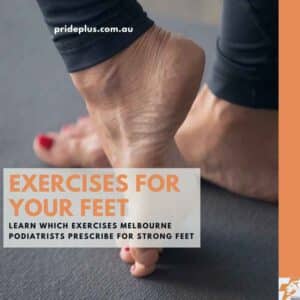Melbourne CBD podiatrist Ella Wright is here to help you understand what treatment for peroneal tendonitis involves for you.
Do you get an aching pain on the outside of your foot or ankle that feels worse after periods of rest? Does the pain get better with small levels of activity, but gets worse again if you continue to move? You may have peroneal tendinopathy, also known as peroneal tendonitis.
What’s that you ask?
Well, let’s talk about what the peroneal tendons do and what treatment for peroneal tendonitis involves.
Peroneal tendonitis is more than just a pain on the outside of your foot
Peroneal tendinopathy AKA peroneal tendonitis are broad terms which describe different conditions and pain of the peroneal tendons. Most of us have two peroneal tendons, called peroneus longus and peroneus brevis. These tendons run from the outside of your lower leg, around the back of your ankle and into your foot.
Peroneal tendinopathy usually involves pain with or without swelling on the outside of your foot and ankle. It occurs as a result of degeneration due to overload of your peroneal tendons.
The most common factors that contribute to peroneal tendonitis are:
Overuse of your peroneal tendons
I’m sure all of us are guilty of increasing our exercise load too much, too quickly.
This is one of the most common contributing factors of peroneal tendinopathy.
Often we’re motivated and we do more physical activity than what our tendons are ready for. Whether that be an increase in our walking or running load, or your may play a sport such as tennis or basketball that involves lots of jumping and side to side movement.
A significant increase in activity puts too much stress on the tendon, particularly if these other factors aren’t also addressed.
Instability or poor balance
Do you struggle to balance on one leg or are you prone to rolling your ankles?
We find that people with peroneal tendonitis have a history of ankle sprains or joint hypermobility. We’re talking about a serious lack of ankle stability. This leads to your peroneal tendons being overworked during activity as they contribute to keeping your ankle nice and stable.
Shoes as a treatment for peroneal tendonitis (or something that makes it worse)
Now let’s talk about shoes!
Loose and flexible footwear leads to an increased risk of developing peroneal tendinopathy. For some of us wearing this type of footwear means that the tendons have to work harder to stabilise the ankle when doing physical activities. Basically the shoes could do the work for us (if they are part of the treatment for peroneal tendonitis) or they can make us work harder (if they are part of the cause).
Podiatrist approved treatment for peroneal tendonitis involves
OK, if you have an overworked and painful peroneal tendon this information can seem daunting. However, have no fear, peroneal tendinopathy is a condition that can often be treated with a few simple interventions.
Load optimisation
Due to overuse being one of the leading causes of your peroneal tendinopathy, load optimisation is a great place to start!
It’s important to look at all forms of activity you do during the week and what footwear you are using to do this. You’ll have to consider not only your regular exercise regime but also whether it has increased.
Then there is the type of movement you do throughout the day. Have you started working back in the office and have to commute on foot to and from the train? Do you walk around the office in your corporate style shoes? Are your once supportive workbooks in need of replacement?
When you figure out how much you are loading your tendon throughout the day, sometimes you’ll need to reduce how much activity you are doing. Just in the short term while you focus on strengthening your tendons.
Increasing capacity: Building strength and stability
Calf raises as an exercise are one of your podiatrists go to treatment for peroneal tendonitis.
Boring? Not here for leg day?
Once you get the habit of appropriately dosed (and techniqued) calf raises happening you’ll come around.
Increasing your strength and stability leads to the tendon having a larger capacity to tolerate the load that you put on it during the day.
Now exercise dosing is as specific and dosing your medications. Just think how your GP and your pharmacist are involved in getting your blood pressure medications just right. Well, when we’re rehabilitating an injured peroneal tendon your exercise dosing is just as precise. Too much, too fast, too little or a poor technique are all sub optimal. If you’re lucky, you won’t make things worse (but won’t improve). If you’re unlucky with your exercise dosing things will get worse.
No matter how much you love your calf raises it’s best to get your initial prescription filled with your podiatrist. Trust me, you’ll appreciate getting this one correct.
Shoes and those inserts known as orthotics
Never underestimate the importance of good footwear! But please remember just because a shoe is expensive, it doesn’t necessarily mean it is good for your feet!
With shoes and orthotics, the aim is to reduce instability and load on the peroneal tendon. Shoes that aren’t too soft and flexible which offer some lateral stability are vital.
Orthotics too help to redistribute where the ground pushes you around and decreases the load on your peroneal tendon. I like to think of it as simply orthotics push underneath to reduce the need for the tendons to pull on top.
Getting the right shoes and the right orthotics for your feet go hand in hand (or should that be foot in foot?). They make a fantastic team when it comes to preventing and treating peroneal tendonitis.
These treatments for peroneal tendonitis aren’t going to fix the sore outside of your foot – if you don’t have the right diagnosis.
It’s important to keep in mind there are a lot of conditions that can contribute to outside of your foot pain. There’s plenty of bones, joints, ligaments, nerves and other tendons which can all become sore.
If you’re suffering your podiatrist is your best first point of call. As foot experts, we’ll help you understand exactly what is sore, why it’s sore, and what you (and us) can do to get it better. Book online with our podiatrists at any of our clinics today.
Frequently asked questions about treatment for peroneal tendonitis
In this rapid fire section I’ll try answer the most common questions that us podiatrists get asked about peroneal tendinopathy.
What are the symptoms of peroneal tendonitis? What does peroneal tendonitis feel like?
The symptoms of peroneal tendonitis vary person to person. There are some commonalities that can include an ache during activity like running or walking. Usually the ache builds up and gets worse the longer your run or walk. You might also feel increased pain in the form of an ache or some sharpness when you first get up in the morning or if you get out of your chair when sitting for long periods of time.
For many people with peroneal tendon pain there is a small window of feeling pretty good. A period of time early during activity where the pain goes away. It might be the 2nd 5 minute period of your walk or run, or it could be some respite after a few really sore first couple of steps in the morning.
Don’t be fooled, this period isn’t your peroneal tendon necessarily getting better, it’s just one of the signals that it is your tendon (and not a peroneal muscle or other area) which is sore.
When can I return to running?
The repetitive ankle motion that is running places high demands on your peroneal tendons. Your podiatrist and physiotherapist will set you up with a return to running plan that is right for you and your goals.
Often, with the right shoes and orthotics you can return to running during the rehabilitation process. A huge win for those who love to, or need to run.
What if I do nothing?
If you do nothing for your peroneal tendonitis a few things can occur. If your loading remains high your tendon will enter a state of disrepair. In this state your tendon thickens and looses it’s elasticity. You also get angiogenesis, blood vessels perforating and growing inside your tendon. These changes mean your tendon is less able to tolerate loads and effectively spring you forwards and keep your balance into the future.
There’s also an elevated risk of developing a peroneal tendon tear. With a partial peroneal tendon tear your at risk of rupture. Increased pain and reduced capacity to run, walk and live an active life are the side effects.
But strangely enough, there are people who do nothing and their peroneal tendon pain gets better. These people tend to naturally reduce their activity in reaction to the pain in their feet. They cut down running, walking or cease their social sports. While these changes might do wonders for your sore foot in the short term they’re hardly the best decisions for your long term health and wellbeing.
Can your peroneal tendon rupture?
Your peroneal tendon can rupture from both acute and chronic overload. It’s best to protect your peroneal tendons by increasing their capacity (and the capacity of their attached peroneal muscles) with appropriately dosed exercises.
Do I need X-rays for my peroneal tendonitis?
Peroneal tendinopathy doesn’t show up on X-ray. You can often (not always) see signs of tendon overload and changes on ultrasound or MRI however these imaging modalities are rarely required for diagnosis.
Your podiatrist will usually make a clinical diagnosis from your history, your physical examination and other assessments.
Will you need surgery for peroneal tendonitis?
Peroneal tendonitis rarely, and I do mean rarely, needs surgery.
Do I need a referral to see a podiatrist for my peroneal tendonitis?
You do not need a referral to see a PridePlus Health podiatrist for your peroneal tendonitis. You can book in at any of our clinics and choose a time that suits you to set your goals and start achieving them.
Now, here’s a caveat.
If you have a chronic medical condition you may be eligible for a small portion of Medicare funding to subsidise your treatment for peroneal tendonitis. For this you would need to see your GP first, have a management plan created and then a referral with an allocation of up to 5 Medicare rebates to see your podiatrist.
Veterans on either a gold or white card still require a referral from their GP for DVA to fund their podiatry.
About The Author

Ella Wright is a podiatrist who just loves treating peroneal tendon injuries. When Ella started consulting with us at PridePlus Health she identified peroneal tendonitis as her favourite condition to help her clients overcome. We hope that this post helps you or someone you love get on track to overcome their sore foot.




